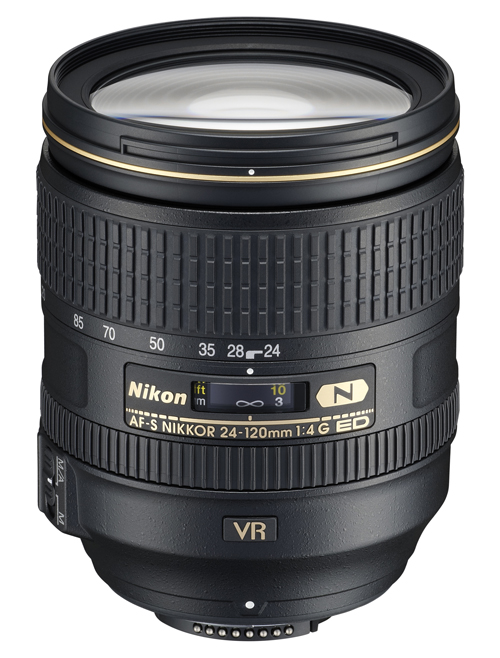Nikon 24-120mm f/4G ED VR
 |
| Nikon's upgraded 24-120mm now has a constant f/4 aperture. Along with its 5x zoom range and vibration reduction, it should be a very interesting all-purpose lens. |
Bearing a gold stripe around the front of the lens barrel, the new version of the popular 24-120mm lens from Nikon promises more than the older variable aperture zoom it replaces. Apart from covering the same zoom range, this lens has a constant maximum aperture of f/4, an updated Vibration reduction system and Nikon's Nano Crystal Coating technology to improve contrast and reduce ghosting and flare. The lens costs around £1045, which is just over £100 cheaper than their flagship in this range, the 24-70mm f/2.8. The older lens is still available and costs around £540, but lacks the constant maximum aperture and Nano Crystal Coatings applied to the new lens.
To put the prince into perspective, Canon's 24-105mm lens is currently available for around £785, which is over £250 less, although the Canon lens lacks the extra reach at the telephoto end.
Not one of the main third party lens manufacturers currently offer a direct equivalent to this lens, although I believe many looking at this lens may look towards their f/2.8 offerings. Tamron's flagship lens in this range is their 28-75mm f/2.8 XR Di, which only costs around £360 and lacks the zoom range and Vibration Reduction and silent focusing of the Nikkor, but does have a brighter maximum aperture. Sigma's 24-70mm f/2.8 IF EX DG HSM, also lacks the range and vibration reduction of the Nikkor, but it does have silent focusing and is available for around £600.
Nikon 24-120mm f/4G ED VR: Handling and features
The first thing many who have used the previous version of this lens will notice is that it feels a fair bit wider than its predecessor. In fact the size and shape of the lens is reminiscent of the much older AF-D 24-120mm f/3.5-5.6, with a wide body tapering steeply towards the lens mount. The design is typical of more modern Nikkors, with a wide rubberised zoom ring placed at the far end of the lens barrel and a narrower focus ring closer to the body.
High quality plastics have been used in much of the construction. Despite this the lens has a reassuringly solid, weighty feel to it with no creaks or wobbles to report. The lens extends in two sections when zoomed to 120mm adding another couple of inches to its length. It's a very smooth action with enough resistance to prevent the lens creeping forward when pointed downwards on a tripod.
Focusing is pretty swift and accurate throughout the zoom range, locking onto static subjects quickly and being able to track moving subjects reasonably well. The vibration reduction system promises to allow sharp shots to be taken at shutter speeds up to four stops slower than without stabilisation. Having pretty steady hands I had no problems taking sharp shots at 120mm and 1/15sec, which is roughly three stops slower than the rule of thumb dictates. At 1/8sec I could get a sharp shot about half the time, which isn't a bad performance really.
Nikon 24-120mm f/4G ED VR: Performance
This optic shows itself capable of producing good centre resolution at most apertures and focal lengths. At 24mm the centre resolution is already very good at maximum aperture and the quality towards the edges is approaching good levels too. Stopping the lens down improves sharpness across the frame until f/11, where the resolution is very good across the frame.
Zooming to 50mm causes a slight drop in sharpness at the centre but at maximum aperture the sharpness is still good here. Peak quality across the frame is found between f/8 and f/11 where the lens produces very good sharpness across the frame.
As with all high zoom lenses the quality falls off, but the performance is still more than acceptable At 120mm the resolution in the centre at maximum aperture is just scraping good and the quality towards the edges is acceptable. Stopping down to f/5.6 causes a huge jump in the resolution at the centre, but the quality towards the edges is only improved a little. Peak quality across the frame is found between f/8 and f/11 where the sharpness is very good across the frame.
Throughout the zoom range chromatic aberrations are kept just within acceptable levels towards the edges. At 50mm and f/4 the levels of fringing reach 0.95 pixel widths which may show in larger prints, but should still be acceptable much of the time.
Falloff of illumination towards the corners is quite noticeable, especially at 24mm and may pose issues for some. At maximum aperture the corners are 2.36 stops darker than the centre. The vignetting is more apparent than with many other lenses as the darkening sets in very suddenly towards the corners at 24mm. The darkening towards the corners is still easy to spot under testing conditions down to f/22, but will probably not pose any issues for real world images from apertures of f/11 or smaller.
At 120mm falloff of illumination towards the corners diminishes, with the corners only being 1.11 stops darker than the image centre. The tradition towards the corners is also much smoother, and is far less noticeable as a result. Images appear visually uniform at f/5.6 at this focal length.
As is often the case with lenses with a high zoom range, barrel distortion at 24mm is quite strong and may pose problems for applications where straight lines are important. Imatest recorded 7.02% barrel distortion, which is really quite high.
Pincushion distortion takes over at 120mm and again is quite strong with Imatest recording a level of 2.22%. Luckily the distortion pattern at each end of the zoom is uniform, so should be quite easy to correct in image editing software afterwards.
Flare and ghosting is well controlled by Nikon's Nano Crystal coating. A little flare and loss of contrast may show when shooting into a bright light source, but only in extreme circumstances. Light sources outside of the frame may also cause a slight loss of contrast, especially at the telephoto end. A petal shaped lens hood is supplied which does an excellent job of keeping unwanted light off the front element and I'd recommend using it all of the time.
 | DxOMark provides objective, independent, RAW-based image quality performance data for lenses and digital cameras to help you select the best equipment to meet your photographic needs. Visit the DxOMark website for tests performed on the Nikon 24-120mm f/4G ED VR. |
Nikon 24-120mm f/4G ED VR: Verdict
By giving their 24-120mm the gold stripe treatment, adding features such as a constant f/4 aperture and Nano Crystal coatings, Nikon have made this lens a serious improvement over the older variable aperture offering. Unfortunately this has also increased the price somewhat, but those who will make the best use of this lens, who wish for a lens that delivers high resolution images over a flexible zoom range will probably not feel too hard done by after stumping up the £1045 required.
The lens does have some weaknesses, such as the strange harsh falloff of illumination in the corners at 24mm and the strong distortion at either end of the zoom. Compromises like these are typical of high zoom range lenses such as this. Many will be plenty pleased enough by the clarity of images produced and excellent build quality to overlook the occasional technical weakness here and there.
Nikon 24-120mm f/4G ED VR: Pros
 Very good sharpness throughout the zoom range
Very good sharpness throughout the zoom range Vibration reduction
Vibration reduction Build quality
Build quality Constant f/4 aperture
Constant f/4 aperture Useful zoom range
Useful zoom rangeNikon 24-120mm f/4G ED VR: Cons
 Harsh vignetting at 24mm
Harsh vignetting at 24mm Distortion at either end of the zoom range
Distortion at either end of the zoom range| FEATURES |  |
| HANDLING |  |
| PERFORMANCE |  |
| VALUE FOR MONEY |  |
| OVERALL |  |
Nikon 24-120mm f/4G ED VR: Lens specification
| Price | £1,045.00 |
| Contact | www.nikon.co.uk |
| Filter size | 77mm |
| Format | Full-frame |
| Construction | 17 elements in 13 groups |
| Angle-of-view | 84˚-20˚ 20’ |
| 35mm equivalent focal length (on APS-C body) | 36-180mm |
| Internal focusing | Yes |
| Image stabilisation | Yes |
| Minimum focus | 45cm |
| Maximum aperture | f/4 |
| Minimum aperture | f//22 |
| Weight | 710g |
| Size | 84 x 103.5mm |
| In the box | Lens Case CL-1218, Lens Hood |
The Nikon 24-120mm f/4G ED VR costs around £1045 and is available from Warehouse Express here:
Nikon 24-120mm f/4G ED VR
Add your message
Login required
Please login here or if you've not registered, you can register here. Registering is safe, quick and free.
Please login here or if you've not registered, you can register here. Registering is safe, quick and free.
photodo Stats
1102 lenses
428 MTF tests
74 in-depth photodo reviews
100+ users join each day
Help the lens community by reviewing or rating a lens today via our lens search
428 MTF tests
74 in-depth photodo reviews
100+ users join each day
Help the lens community by reviewing or rating a lens today via our lens search
Latest Lens Reviews
- Chinon 28mm f/2.8 Vintage Lens Review
- Canon EF 70-200mm f/4L IS II USM Lens Review
- Samyang AF 85mm f/1.4 EF Review
- Sigma 70mm f/2.8 DG Macro Art Review
- Samyang AF 24mm f/2.8 FE Review
- Meike 50mm f/1.7 Review
- Tamron 70-210mm f/4 Di VC USD Review
- Lensbaby Burnside 35mm f/2.8 Review
- Asahi Super Takumar 50mm f/1.4 Review
- Asahi Super-Multi-Coated Takumar 135mm f/3.5 Review








